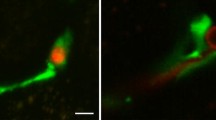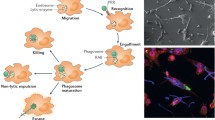Abstract
Human peripheral monocytes (MO), neutrophils (PMN), and lymphocytes (PBL) were tested for their ability to kill Candida tropicalis. With incubation times between 30 min and 2 h, unstimulated MO and PMN, but not PBL, were efficient killers of C. tropicalis. Both leukocyte subsets were able to kill at minimum 2.5∶ 1 effector to target ratios. Pre-incubation of MO for 24 h with interferon-gamma or tumor necrosis factor (TNF) increased their ability to kill yeast targets. TNF alone had no effect on C. tropicalis targets at concentrations up to 1000 U/ml. PBL activated for 4 d with interleukin-2 did not kill yeast targets. PMN exhibited more cytocidal efficiency per cell than MO in these assays. Direct contact of effectors and targets was required; no significant killing by PMN or MO supernatants was measured. PMN-mediated killing, but not MO killing, was inhibited by a mixture of catalase and Superoxide dismutase suggesting that oxygen-dependent killing mechanisms were partially responsible for candidacidal activity.
Similar content being viewed by others
References
Baccarini M, Blasi E, Puccetti P, Bistoni F. Phagocytic killing of Candida albicans by different murine effector cells. Sabouraudia 1983; 21: 271–86.
Bille J, Stockman L, Roberts GD. Detection of yeasts and filamentous fungi in blood cultures during a 10-year period. J Clin Microbiol 1982; 16: 968–70.
Brune K, Schmid L, Glatt M, Minder B. Correlation between antimicrobial activity and peroxidase content of leukocytes. Nature 1973; 245: 209–10.
Cockayne A, Odds FC. Interactions of Candida albicans yeast cells, germ tubes and hyphae with human polymorphonuclear leukocytes in vitro. J Gen Microbiol 1984; 130: 465–71.
Csato M, Bozoky B, Hunyadi J, Dobozy A. Candida albicans phagocytosis by separated human epidermal cells. Arch Dermatol Res 1986; 279: 136–9.
Danley DL, Polakoff J. Rapid killing of monocytes in vitro by Candida albicans yeast cells Infect Immun 1986; 51: 307–13.
Decker T, Lohmann-Matthes M-L, Baccarini M. Heterogeneous activity of immature and mature cells of the murine monocyte-macrophage lineage derived from different anatomical districts against yeast-phase Candida albicans. Infect Immun 1986; 54: 477–86.
Diamond RD, Haudenschild CC. Monocyte-mediated serum-independent damage to hyphal and pseudohyphal forms of Candida albicans in vitro. J Clin Invest 1981; 67: 173–82.
Diamond RD, Krzesicki R. Mechanisms of attachment of neutrophils to Candida albicans pseudohyphae in the absence of serum, and of subsequent damage to pseudohyphae by microbicidal processes in vitro. J Clin Invest 1978; 61: 360–9.
Djeu JY, Blanchard DK, Halkias D, Friedman H. Growth inhibition of Candida albicans by human polymorphonuclear neutrophils: activation by interferongamma and tumor necrosis factor. J Immunol 1986; 137: 2980–4.
Dyess DL, Garrison RN, Fry DE. Candida sepsis. Arch Surg 1985; 120: 345–8.
Hidore MR, Murphy JW. Correlation of natural killer cell activity and clearance of Cryptococcus neoformans from mice after adoptive transfer of splenic nylon wool nonadherent cells. Infect Immun 1985; 51: 547–55.
Lehrer RI. Functional aspects of a second mechanism of candidacidal activity by human neutrophils. J Clin Invest 1972; 51: 2566–72.
Lehrer RI, Cline MJ. Interaction of Candida albicans with human leukocytes and serum. J Bacteriol 1969; 98: 996–1004.
Lindemann RA, Economou JS, Rothermel H. Production of interleukin-1 and tumor necrosis factor by human peripheral monocytes activated by periodontal bacteria and extracted lipopolysaccharides. J Dent Res 1988; 67: 1131–5.
Meunier-Carpentier F, Kiehn, TE, Armstrong D. Fungemia in the immunocompromised host. Am J Med 1981; 71: 363–70.
Odds FC. Candida and candidosis. A review and bibliography. Second ed. London: Bailliere Tindall, 1988: 270.
Pereira HA, Hosking CS. The role of complement and antibody in opsonization and intracellular killing of Candida albicans. Clin Exp Immunol 1984; 57: 307–14.
Phillips JH, Lanier LL. Dissection of the lymphokineactivated killer phenomenon. Relative contribution of peripheral blood natural killer cells and T lymphocytes to cytolysis. J Exp Med 1986; 164: 814–25.
Pross HF, Baines MG, Rubin P, Shragge P, Patterson MS. Spontaneous human lymphocyte-mediated cytotoxicity against tumor target cells. IX. The quantitation of natural killer cell activity. J Clin Immunol 1981; 1: 51–63.
Richardson MD, Gray CA. Enhancement of phagocytosis and intracellular killing of Candida albicans by human neutrophils in the presence of a morpholine antifungal derivative Ro 14-4767. Ann N Y Acad Sci 1988; 544: 403–5.
Sasada M, Kubo A, Nishimura T, Kakita T, Moriguchi T, Yamamoto K, Uchino H. Candidacidal activity on monocyte-derived human macrophages: relationship between Candida killing and oxygen radical generation by human macrophages. J Leuk Biol 1987; 41: 289–94.
Seeley JK, Golub SH. Studies on cytotoxicity generated in human mixed lymphocyte cultures. I. Time course and target spectrum of several distinct concomitant cytotoxic activities. J Immunol 1978; 120: 1415–22.
Shau H. Characteristics and mechanism of neutrophilmediated cytostasis induced by tumor necrosis factor. J Immunol 1988; 141: 234–40.
Shau H, Kim A. Suppression of lymphokine-activated killer induction by neutrophils. J Immunol 1988; 141: 4395–402.
Smail EH, Melnick DA, Ruggeri R, Diamond RD. A novel natural inhibitor from Candida albicans hyphae causing dissociation of the neutrophil respiratory burst response to chemotactic peptides from other post-activation events. J Immunol 1988; 140: 3893–9.
Tewari RD, Mkwananzi JB, McConnachig P, Von Behren LA, Eagleton L, Kulkarni P, Bartlett PC. Natural and antibody dependent cellular cytotoxicity (ADCC) of human peripheral blood mononuclear cells (PBMC) to yeast cells of Histoplasma capsulatum (HC). Am Soc Microbiol Abstracts 1981; (F66): 324.
Timonen T, Ortaldo, JR, Herberman RB. Characteristics of human large granular lymphocytes and relationship to natural killer and K cells. J Exp Med 1981; 153: 569–82.
Wagner DK, Collins-Lech C, Sohnle PG. Inhibition of neutrophil killing of Candida albicans by substances which quench hypochlorous acid and chloramines. Infect Immun 1986; 51: 731–5.
Author information
Authors and Affiliations
Rights and permissions
About this article
Cite this article
Lindemann, R.A., Franker, C.K. Phagocyte-mediated killing of Candida tropicalis . Mycopathologia 113, 81–87 (1991). https://doi.org/10.1007/BF00442414
Received:
Accepted:
Issue Date:
DOI: https://doi.org/10.1007/BF00442414




